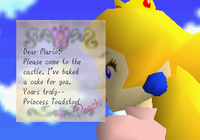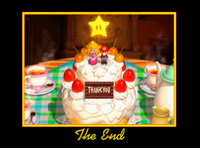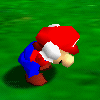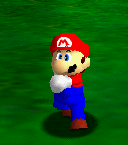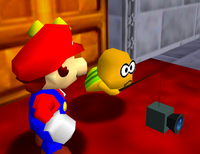Super Mario 64: Difference between revisions
| Line 391: | Line 391: | ||
[[File:Lakitu glitch.png|thumb|Lakitu without his cloud after the process of the glitch.]] | [[File:Lakitu glitch.png|thumb|Lakitu without his cloud after the process of the glitch.]] | ||
At the beginning of the game, the player can make a [[Long Jump (move)|Long Jump]] on the exact edge of the bridge. If they succeed, the player won't need to talk to Lakitu. He will be standing in front of the castle, without his cloud. | At the beginning of the game, the player can make a [[Long Jump (move)|Long Jump]] on the exact edge of the bridge. If they succeed, the player won't need to talk to Lakitu. He will be standing in front of the castle, without his cloud. | ||
==={{conjecturaltext|Lose Cap Permanently}}=== | |||
Occasionally, in Snowman's Land, if Mario gets blown off the icy bridge by the snowman at just the right angle, his cap will fall into the ice box with a star in it (from In the Deep Freeze). If Mario tries to grab his cap, he will instead grab the star. If the player saves the game at this point, then Mario will be permanently capless. | |||
==Staff== | ==Staff== | ||
Revision as of 15:05, July 6, 2014
It has been requested that this article be rewritten.
Template:Infobox Super Mario 64 is a 3D action-adventure platformer game released for the Nintendo 64 in 1996. This game was one of two (three in Japan) launch titles for the Nintendo 64, along with Pilotwings 64, which helped drive initial sales of the console. To this day, it has sold nearly over 11 million copies, and is marked as the best selling Nintendo 64 game of all time. It is also the second most popular game on the Wii's Virtual Console, after Super Mario Bros.
Being the first 3D Mario game, Super Mario 64 introduced many moves that would be used in almost every later Super Mario title: Triple Jumping, Ground Pounding, Long Jumping, Crouching, and Somersaults. Punching and kicking were also introduced, but would not be used in any later main title (besides its DS remake).
Super Mario 64 was originally in development for the Super Famicom, (SNES outside of Japan), but was moved to the Nintendo 64 after system limitations and the 16-bit era began closing[1], not to mention a lack of proper controls (as the game defined the design of the N64 controller[2]). Though it was not the first 3D platforming game, it revolutionized the genre, with many games soon following its formula using it as a sort of benchmark[3]. It is widely acclaimed as one of the greatest and important games of all time[4][5][6].
A remake of Super Mario 64 was released for the Nintendo DS entitled Super Mario 64 DS in 2004. The remake had various differences from the original game such as Luigi, Yoshi, and Wario becoming playable characters. There was also a sequel called Super Mario 64 2 planned for the Nintendo 64DD, but it was cancelled due to the 64DD's commercial failure.
Storyline
Princess Toadstool (or "Peach", as she is called for the second time in the western world since Yoshi's Safari introduced it) sent a letter to Mario to come and have some cake with her in the castle. When Mario arrives, he finds one of the Lakitu Bros. who follows him around holding a camera and filming him. Together, they go inside and hear a familiar voice telling them to get out of the castle, actually being Bowser. Toad informs them that Bowser has kidnapped Peach again and is holding everyone hostage inside the castle walls. He has also stolen the 120 Power Stars and given them to his minions who are hiding in the paintings that are accessible from inside the castle. Mario must jump into each painting scattered around the castle in order to retrieve the power stars.
Toad informs Mario about a Bob-omb field where Big Bob-omb must be faced. The first of many power stars can be found here. By obtaining more Power Stars, Mario unlocks doors to three more paintings in the castle including the Whomp's Fortress, Jolly Roger Bay, Cool, Cool Mountain, and the ability to collect more stars.
When Mario collects eight Power Stars, he can open the Star Door at the left side of the castle. He then falls through the floor in the room and enters the first Bowser Course, Bowser in the Dark World. After travelling through the course, he enters a warp pipe, which leads him to Bowser. After evading Bowser's attacks and grabbing his tail, Mario throws him into a bomb on the edge of the stage defeating him. Unfortunately, it turns out that Bowser doesn't have Peach with him. Instead, he floats into the air and disappears, leaving a key for Mario to collect. Mario then obtains the key that allows him to enter the basement of the castle. The basement contains four levels, which are Lethal Lava Land, Shifting Sand Land, Hazy Maze Cave, and Dire, Dire Docks. After collecting 30 stars, Mario is granted with the ability to open another star door in the basement. The Star Door leads to a room with the entrance to Dire, Dire Docks and the second Bowser course, Bowser in the Fire Sea. After navigating through the course, Mario jumps into another battle with Bowser. This battle can be more challenging than the last one, since Bowser can now teleport and tilt the stage. Also, the distance between the arena platform and the bombs has increased. When Mario defeats Bowser for the second time, Mario gains a key to the second floor leading to even more paintings. After Mario collects his 50th Power Star, he can go up to the third floor, and once Mario collects 70 Power Stars, he can access the door into Bowser's final stage, Bowser in the Sky, and go through another one of his obstacle courses. After he finds the warp pipe at the end of the course, Mario finds Bowser waiting for him. The two then begin to engage in battle. This time, Bowser has to be blown up by a bomb three times. When Bowser gets blown up twice, certain parts of the arena fall away, leaving the platform in a shape of giant star. Bowser ends up defeated, and is surprised when Mario tells him there were some Power Stars he missed; the Castle's Secret Stars. Bowser gives up, and hands Mario the final Grand Power Star before he disappears. When Mario grabs the last power star, wings appear on his cap, allowing him to fly. He circles the star-shaped arena, and flies away. Eventually, he lands in front of the castle.
As his wings fade away, Mario uses the power of the Giant Power Star to save Peach and take her back at the front of the castle. The star goes into the stained glass window over the front door of the castle, the window flashes, and Peach slowly descends to the ground. Mario rushes up to her as she opens her eyes. Thanking him, Peach kisses Mario on the nose and says she will bake a cake for him. Peach and two nearby Mushroom Retainers walk into the castle. Mario starts to do so himself, but then pauses and turns around to look at the upward. Peach calls him, and he rushes after her. After the credits scroll, Mario, Peach and two Toads wave goodbye to the player, followed by the cake, with Peach and Mario figures, shown at the very end. The game will then freeze, and the console will have to be turned off or restarted. (This was customary for beating the final Boss at the time, since "extra mode" was not a popular concept.)
Courses
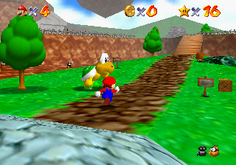
Levels are laid out inside paintings in the castle, or sometimes the walls themselves. They can also be found in holes, gaps, oil pits, and inside a clock. Each world has seven Power Stars. Within each, one of which is gained by finding one hundred coins in the level. The other six Power Stars are found by performing "missions", fighting bosses, winning races, etc. Every course has boundaries to limit the player from going too far, either as a strict wall or an invisible boundary. If Mario hits either, he falls down (quite often losing a life). Otherwise, Mario is free to roam the large expansive levels at his leisure.
Levels often feature pink Bob-ombs called Bob-omb Buddies. They open cannons littered around the levels for Mario to fly with. When the cannon is open, Mario simply falls into the pit where it is, and it raises. The player targets the cannon with a cross hair shot, and fires. This helps Mario reach high or far away areas. It is often a good idea to use the Wing Cap (see below) with cannons.
| Bob-omb Battlefield | Whomp's Fortress | Jolly Roger Bay | |||
|---|---|---|---|---|---|
| Big Bob-omb on the Summit | Footrace with Koopa the Quick | Chip Off Whomp's Block | To the Top of the Fortress | Plunder in the Sunken Ship | Can the Eel Come Out to Play? |
| Shoot to the Island in the Sky | Find the 8 Red Coins | Shoot Into the Wild Blue | Red Coins on the Floating Isle | Treasure in the Ocean Cave | Red Coins on the Ship Afloat |
| Mario Wings to the Sky | Behind Chain Chomp's Gate | Fall Onto the Caged Island | Blast Away the Wall | Blast to the Stone Pillar | Through the Jet Stream |
| Cool, Cool Mountain | Big Boo's Haunt | Hazy Maze Cave | |||
| Slip Slidin' Away | Li'l Penguin Lost | Go on a Ghost Hunt | Ride Big Boo's Merry-Go-Round | Swimming Beast in the Cavern | Elevate for 8 Red Coins |
| Big Penguin Race | Frosty Slide for 8 Red Coins | Secret of the Haunted Books | Seek the 8 Red Coins | Metal-Head Mario Can Move! | Navigating the Toxic Maze |
| Snowman's Lost His Head | Wall Kicks Will Work | Big Boo's Balcony | Eye to Eye in the Secret Room | A-Maze-ing Emergency Exit | Watch for Rolling Rocks |
| Lethal Lava Land | Shifting Sand Land | Dire Dire Docks | |||
| Boil The Big Bully | Bully The Bullies | In the Talons of the Big Bird | Shining Atop the Pyramid | Board Bowser's Sub | Chests In The Current |
| 8-Coin Puzzle With 15 Pieces | Red-Hot Log Rolling | Inside the Ancient Pyramid | Stand Tall On the Four Pillars | Pole-Jumping For Red Coins | Through The Jet Stream |
| Hot-Foot It Into the Volcano | Elevator Tour In The Volcano | Free-Flying For 8 Red Coins | Pyramid Puzzle | The Manta Ray's Reward | Collect the Caps... |
| Snowman's Land | Wet-Dry World | Tall, Tall Mountain | |||
| Snowman's Big Head | Chill with the Bully | Shocking Arrow Lifts | Top o' the Town | Scale the Mountain | Mystery of the Monkey Cage |
| In the Deep Freeze | Whirl From the Freezing Pond | Secrets in the Shallows and Sky | Express Elevator--Hurry Up! | Scary 'Shrooms, Red Coins | Mysterious Mountainside |
| Shell Shredding for Red Coins | Into the Igloo | Go to Town for Red Coins | Quick Race Through Downtown! | Breathtaking View from Bridge | Blast to the Lonely Mushroom |
| Tiny-Huge Island | Tick Tock Clock | Rainbow Ride | |||
| Pluck the Piranha Flower | The Tip Top of the Huge Island | Roll into the Cage | The Pit and the Pendulums | Cruiser Crossing the Rainbow | The Big House in the Sky |
| Rematch with Koopa the Quick | Five Itty Bitty Secrets | Get a Hand | Stomp on the Thwomp | Coins Amassed in a Maze | Swingin' in the Breeze |
| Wiggler's Red Coins | Make Wiggler Squirm | Timed Jumps on Moving Bars | Stop Time for Red Coins | Tricky Triangles | Somewhere Over the Rainbow |
Secret Stars
In addition to the main courses of the game and the Bowser Courses, there are also a few hidden courses that house several of the Castle's Secret Stars, as well as the three ! Switches.
- The Princess's Secret Slide (2 Stars)
- The Secret Aquarium (1 Star)
- Tower of the Wing Cap (Wing Cap) (1 Star)
- Vanish Cap Under the Moat (Vanish Cap) (1 Star)
- Cavern of the Metal Cap (Metal Cap) (1 Star)
- Bowser in the Dark World (1 Star)
- Wing Mario Over the Rainbow (1 Star)
- MIPS the Rabbit (2 Stars)
- Toad's Secured Stars (3 Stars)
- Bowser in the Fire Sea (1 Star)
- Bowser in the Sky (1 Star)
Enemies
New Enemies
Returning Enemies
Abilities
In addition to Mario's signature jumping, a whole new host of abilities is given to the player. Mario can punch, kick, kick jump, hip drop (Ground Pound, something Yoshi and Wario could do in previous games), triple jump, long jump, back flip, somersault, and perform the wall kick (bouncing from wall to wall with timed jumps to reach higher areas). The usual Super Mushroom and Fire Flower are absent in this game. Instead as the game progress, Mario gains the power to wear new hats, in the form of colored Caps, with multiple abilities exclusive to each. The Power Gauge is also introduced in a circular form which became standard for future three dimensional "Mario" games, (though it made an appearance beforehand, in a vertical form, in Super Mario Bros. 2).
The Caps are found inside special '!' blocks littered around the every level. Initially empty, they can be filled by finding '!' switches (similar to the Switch Palaces of Super Mario World). There are three colors to the caps, and each cap lets Mario perform different abilities. Only one (or occasionally two) forms of colored caps are in each level. Normally, each cap is worn separately, but Mario can sometimes don two caps at once and combine the abilities of both.
- The Wing Cap (red) allows Mario to transform into Wing Mario and fly around if he performs a triple jump or blasts out of a cannon. This is useful for reaching high or far areas, and finding secrets in the sky. Also, the Wing Cap lets Mario do a Triple Jump without having to walk/run.
- The Vanish Cap (blue) makes Mario transform into Vanish Mario which makes him invulnerable to attacks. He can also walk through some walls to reach new areas, where he can find hidden items or Power Stars. Also, all enemies' attacks travel through him.
- The Metal Cap (green) causes Mario to transform into Metal Mario, which makes him metallic and heavy. This lets Mario defeat enemies by walking into them, walk through streams of fire without taking damage, avoid water currents, and walk under water. Because of his weight, all Mario can do in this form is walk and jump.
Bosses
There are various mini bosses in some stages, but the primary boss is Bowser. He appears three times in three different levels. This is a list of the bosses in the game.
- Big Bob-omb - A giant Bob-omb in Bob-omb Battlefield. He appears as the first boss in the game, and the first star.
- Whomp King - A giant Whomp on top of Whomp's Fortress. He appears as the first star, and after he is defeated, there is a tower on top of the fortress.
- Bowser in the Dark World - Bowser appears at the end of this level. The player needs to swing him by the tail clockwise or counterclockwise and hurl him at bombs on the outside of his circular arena.
- Big Bully - Two of these giant Bullies appear in Lethal Lava Land. On both occasions they try to knock Mario into the lava.
- Eyerok - Two stone hands with eyes on their palms. They appear when the player blasts open the top of the Pyramid in Shifting Sand Land and ride the elevator inside.
- Big Boo - A giant Boo which appears three times in Big Boo's Haunt. He initially appears once all the Boos in the mansion have been removed, again in the underground Merry-Go-Round, and lastly on the top balcony of the mansion (possibly what inspired Boolossus).
- Big Mr. I - A giant Mr I which only appears in the attic of Big Boo's Haunt.
- Bowser in the Fire Sea - Bowser appears at the end of the level. Game play is the same as the first Bowser, except now his jumps make the arena tilt, causing Mario to need to run up the arena to avoid falling off. Bowser also gains a new move where he vanishes and reappears a short distance away.
- Chill Bully - A large Bully made of ice. He tries to ram Mario onto a lethally frozen pond in Snowman's Land.
- Wiggler - A giant Wiggler, which becomes angry when his home in Tiny-Huge Island gets flooded.
- Bowser in the Sky - Bowser appears at the end of this level. He must be thrown into the bombs three times. Each time he falls off the arena, his jump back makes a piece of the arena fall off. After being hit twice, he stomps the ground and more of the arena will fall off, which then the remaining section of the arena becomes star shaped. Once Bowser gets hit the third time, he will be defeated, leaving behind a Giant Star, which is not added to the Power Star total after it is collected. The game will then be completed.
Notable mistakes and errors
- When speaking to Yoshi on the castle roof, Yoshi says "Mario!!! It that really you???" instead of "Mario!!! Is that really you???".
- If Mario is one star short of opening a door, it will still refer to the word needed in the plural: "You need 1 more stars" instead of "You need 1 more star."
Those errors remained in the Virtual Console version. However, they were fixed in the remake, as Yoshi is a playable character, and the message that appears when Mario doesn't have enough stars to open a door is "You need 1 more."
References to other games
- Super Mario Bros. - A carving of Mario from this game appears on a pillar in Bowser in the Sky. There is also a small jingle used at the Power Star select screen which sounds identical to the first few notes of the opening theme in this game.
- Super Mario World - The idea of Switch Palaces is in a way brought back. Also, when Yoshi is met, he says to Mario "It has been so long since our last adventure!", referring to this game. Also, the soundtrack follows the same composition technique used in Super Mario World in a similar way where there's a signature melody in the game that's heard across different levels in several variations (Bob-omb Battlefield, Snow Mountain, Slider).
- Super Mario World 2: Yoshi's Island - The theme used for invincibility in this game, specifically the string instruments playing in the background, is reworked into Wing/Vanish Mario's theme for Super Mario 64.
References in later games
- Paper Mario - This game starts the same way, with a letter being sent from Peach. Peach's Castle returns and the main room is near identical (however the doors do lead to different rooms).
- Super Mario 64 DS - This game is a remake of Super Mario 64. Also, at the start, Yoshi is on the roof and jumps down, a reference to the fact that he is there at the end of Super Mario 64.
- Mario Kart 64 - Peach's Castle is hidden on Royal Raceway and its appearance is identical to Super Mario 64. The castle grounds are also there and unchanged between the two games. The drawback is the castle is inaccessible. Penguins in Sherbet Land have a identical appearance and a big penguin (most likely Penguin Champ) is in the center of the course on an island of ice.
- Super Smash Bros. - Most of Mario's moves, animations and his voice clips in this game are derived from the ones in Super Mario 64. Metal Mario appears as a boss. Two levels based on places here are also accessible, such as Metal Mario's stage and Peach's Castle. Although Luigi didn't appear in the game, his moves and his voice clips are identical to Mario's in Super Mario 64 except Luigi's voice clips is Mario's voice clips sped up.
- Mario Kart: Super Circuit - Peach's Castle re-appears in the background of Peach Circuit, Mario Circuit 1 and Mario Circuit 4.
- Mario Kart DS - Tick Tock Clock appears as a race track in this game. Several bosses found here also reappear in this game.
- New Super Mario Bros. - This game uses many things found here, such as Dorrie, and a Bowser head closes in on the screen when the player dies. Some enemies like Whomps, Moneybags and Scuttle Bugs make their platforming debut. Also, Wing/Vanish Cap theme is present for Invincibility.
- Paper Mario: The Thousand-Year Door - The game starts in the same way, Peach sends Mario another letter.
- Mario & Luigi: Superstar Saga - In Woohoo Hooniversity, a room with four blocks can be seen in it. One of them is a block from Super Mario 64. The name of the game is even mentioned in the description of the blocks, and the professors are trying to figure out why it vanishes when struck.
- Super Mario Galaxy - The game starts in the same way, with Peach sending Mario another letter. Also, the Bowser's Road theme is covered for Bowser's Star Reactor. Also, the falling asleep idle animation returns.
- Super Smash Bros. Melee - Two stages based on areas from Super Mario 64 appear: Princess Peach's Castle (which also appears as a trophy) and Rainbow Ride (which also includes a cover of the Super Mario 64 - Slide music). Metal Mario re-appears as a boss and trophy. Additionally, the Metal Box returns in this game as an item and a trophy. Mario still has his voice clips, moves, and animations and Luigi still has Mario-like voice clips, moves, and animations.
- Super Smash Bros. Brawl - Music from Bob-omb Battlefield is unlockable, and the Rainbow Ride stage/music and Metal Box from the previous game returns as well.
- Donkey Kong Country 3: Dixie Kong's Double Trouble! - Wrinkly Kong plays this game sometimes in her Save Caves. The theme of Wrinkly's Save Caves is also very similar to the song Inside the Castle Walls.
- Super Mario Sunshine - A brief clip of Mario's fight with Bowser is seen when F.L.U.D.D. scans Mario.
- Mario Power Tennis - The music that plays in the minigame, Artist On the Court has the Peach Castle theme covered.
- Super Mario Galaxy 2 - In both Tall Trunk Galaxy and Rolling Coaster Galaxy, The Princess's Secret Slide music plays at a moment. Also, the Whomp's Fortress reappears as the Throwback Galaxy, alongside Bob-omb Buddies and the Whomp King. Both games start with Peach sending a letter to Mario. Also, the orchestral cover of Bowser's Road theme can be heard in Bowser's Lava Lair and Bowser's Gravity Gauntlet.
- New Super Mario Bros. Wii - Peach's Castle reappears in the game, along with its trademark music covered. Big Venus Fire Traps reappear in this game.
- Mario & Luigi: Partners in Time - The theme that plays in Peach's Castle is a cover version of this game's castle theme. Also, ! Blocks appear in this game.
- Mario & Luigi: Bowser's Inside Story - The music for when the Mario Bros first enter Peach's Castle and when everyone is removed from Bowser's Belly is a cover of the Peach's Castle theme. Also, both games end in a view of a cake with Mario and Peach figures on it.
- Mario Strikers Charged - A cover of the music that plays in Big Boo's Merry-Go-Round is featured in this game, as the theme associated with Boo sidekicks.
- Mario & Sonic at the Olympic Winter Games - The Cool, Cool Mountain and Snowman's Land course music is covered for the Dream Snowball Fight event in this game. The main theme and the Bowser's stage theme is also used.
- Super Mario 3D Land - The sound effect of Mario falling from heights is reused, plus the platforming style is mixed together with Super Mario Bros 3 and Super Mario Galaxy. Also, when the player waits outside a purple Mystery Box on the map screen, the endless stairs music from Super Mario 64 can be heard.
- Mario Kart 7 - Metal Mario appears as a playable character.
- Mario Tennis Open - A cover of Peach's Castle is used in Peach's Palace. In the Bowser's Castle court, a cover of the Bowser battle music is played.
- New Super Mario Bros. 2- The first few notes of the Peach's Castle theme are played during the intro.
- Paper Mario: Sticker Star- The Princess's Secret Slide music is covered during the Minecart part of Bowser's Snow Fortress.
- New Super Mario Bros. U- The castle moat appears in the game but it is inaccessible due to it only appearing on the world map and, when Peach's Castle is entered, the moat is seen as lava.
- Super Mario 3D World- A cover of The Princess's Secret Slide music plays when riding Plessie. Additionally, Bullies return in this game, as well as a new shark enemy with a similar design to Sushies. In Shifty Boo Mansion, a level in Super Mario 3D World, there is a Green Star hidden behind a portrait of a Boo that can be entered like the pictures in Princess Peach's Castle.
- Mario Party: Island Tour- A cover of Koopa's Road plays in Bowser's Peculiar Peak.
- Mario Kart 8 - Princess Peach's Castle reappears in the retro course Royal Raceway.
Media
- Main article: List of media from Super Mario 64
Reissues
- Main article: Super Mario 64 DS
Super Mario 64 DS is the remake of the game for the Nintendo DS, bearing some new features on its storyline, gameplay and graphics. Unlike Super Mario 64, Mario is not the only playable character (nor is he even available at the start, the only character available at the start of the game is Yoshi); Yoshi, Luigi, and Wario also join the adventure in order to rescue Princess Toadstool from the hands of Bowser. Other new features within the game include a multi-player mode, in which up to four players can play simultaneously on each Nintendo DS connected together locally; minigames to play with each character, and new additions to the story mode such as new missions and levels.
A version of the original game was released in Japan on July 18, 1997, that included Rumble Pak support. This game is the same as the International release of the game, as it retains all of the glitch fixes as well as graphical and sound changes (except Mario calling Bowser by his name in the "So long-a Bowser" voice clip, which was "buh-bye" in all Japanese versions as he tosses him by the tail - this is because he is not known as Bowser in Japan; instead he is known as Koopa). The only differences other than one voice clip are the language being changed back to Japanese and the Rumble Pak support.
Official soundtrack
- Main article: Super Mario 64 Original Soundtrack
An original soundtrack that is based on the game is released. It has thirty-six tracks from the game.
Gallery
- Bowsersm64.gif
Bowser
- Sm64 the big boo.png
Boo
- Powerstar64.png
Power Star
Beta elements
- Main article: List of Super Mario 64 beta elements
The most notable beta element is the Blargg, which is still in the game's data, that would appear in the Lethal Lava Land, Bowser in the Fire Sea, And Wing Mario over the Rainbow stages. Also, Big Boo held a key instead of a Star inside of him. The purpose of the keys was to unlock a variety of the various doors in Big Boo's Haunt - there was even a "key counter". 32 levels were planned for the game, but only fifteen of them made it into the final product.
Reception
Super Mario 64 received critical acclaim, garnering a score of 9.8 from IGN, 9.4 from GameSpot, and 9.75 from Game Informer. It has been praised for its gameplay elements, innovative graphics (due to the game's transition of the Mario series from 2D to 3D graphics), and for its musical composition. However, the game has received its fair share of criticism for its automatic camera following. Critics complained that the camera would sometimes shift erratically, interrupting gameplay.
Super Mario 64 is the best selling game for the Nintendo 64, selling 11.62 copies worldwide, as of December 31, 2009.
Glitches
- Main article: List of glitches in Super Mario 64
The most famous glitch is probably the Template:Conjecturaltext which will let the player climb any stairs including the Endless Stairs. Another famous glitch is the Template:Conjecturaltext which is Mario being trapped in the castle walls.
Template:Conjecturaltext
This glitch is done by going to the stairs leading to the second floor of Princess Peach's Castle. On the staircase just after a few steps if the player moves Mario against the wall, change to the zoomed camera, tilt the camera so it goes to the left of Mario and through the wall, the player can see the cloud as it looks similar to a Fwoosh or the cloud a Lakitu is riding.
This can also be made when Mario stands at the left part of the stairs in the Third Floor (that leads to a door to the Endless Staircase).
Template:Conjecturaltext
This is a very difficult glitch to pull off. Mario must be in either Jolly Roger Bay or Dire Dire Docks. He must dive to where a jet stream is. Next, the player must press ![]() , and just as Mario stops his pose the player must do it again. He or she must repeatedly do so, and, although it's hard to do, if done correctly Mario will be inside the jet stream. This can be used to collect the "Through the Jet Stream" stars without the Metal Cap.[7]
, and just as Mario stops his pose the player must do it again. He or she must repeatedly do so, and, although it's hard to do, if done correctly Mario will be inside the jet stream. This can be used to collect the "Through the Jet Stream" stars without the Metal Cap.[7]
Template:Conjecturaltext
At the beginning of the game, the player can make a Long Jump on the exact edge of the bridge. If they succeed, the player won't need to talk to Lakitu. He will be standing in front of the castle, without his cloud.
Template:Conjecturaltext
Occasionally, in Snowman's Land, if Mario gets blown off the icy bridge by the snowman at just the right angle, his cap will fall into the ice box with a star in it (from In the Deep Freeze). If Mario tries to grab his cap, he will instead grab the star. If the player saves the game at this point, then Mario will be permanently capless.
Staff
- Main article: List of Super Mario 64 staff
Game director
- Shigeru Miyamoto
Assistant directors
- Yoshiaki Koizumi
- Takashi Tezuka
Mario face programmer
- Giles Goddard
Course designers
- Kenta Usui
- Naoki Mori
- Yoshiki Haruhana
- Makoto Miyanaga
- Katsuhiko Kanno
Trivia
- When Super Mario 64 was being localized for the English speaking countries, many small changes were made. For example, Princess Peach never reads her letter aloud in the Japanese version of Super Mario 64. In 1997, Super Mario 64 was re-released in Japan as Super Mario 64 Shindō Pak Taiō Version (スーパーマリオ64振動パック対応バージョン), along with Wave Race 64. It featured all the changes from the English game, plus Rumble Pak support and minor glitch fixes.
- In North America, Super Mario 64 was released three days before the launch of the Nintendo 64 system itself, much like when Luigi's Mansion was released one day before the release of the Nintendo GameCube.[8]
- If a second controller is plugged into the N64, it can be used to control the camera while Peach congratulates Mario during the credits.
- This game defined the layout of the N64 controller. The
 was added for better multi-directional movement, and the
was added for better multi-directional movement, and the  were added for free camera control. This implies that a lack of control options, not just the need for better processing power, was what pushed the game from the SNES to the N64.[9]
were added for free camera control. This implies that a lack of control options, not just the need for better processing power, was what pushed the game from the SNES to the N64.[9] - Super Mario 64 was one of the games featured at The Art of Video Games exhibition at the Smithsonian American Art Museum in 2012.[10] The game won voting in the "action" category for the Nintendo 64, beating out Banjo-Kazooie and Star Wars: Shadows of the Empire.
- For voice acting, Super Mario 64 is more recognized as the first game where Charles Martinet voiced Mario, but the actual first game was the 1995 PC Mario game Mario's FUNdamentals.
- Super Mario 64 actually doesn't use the full 64-bit capabilities of the N64 which is misleading,the game actually runs in 32-bit as so did most N64 games back then.
- This is one of the two games that marks the first time Mario, Peach, Bowser, and Toad receive a revamped appearance from the original hand-drawn era to the N64 3-D art direction of the Mario franchise. The other being Mario Kart 64.
References
- ^ N-Sider.com: Profile - Shigeru Miyamoto
- ^ http://www.youtube.com/watch?v=glC3zXaJjtQ
- ^ GameSpot - 15 Most Influential Games of All Time
- ^ GameFaqs - The top 10 games Ever
- ^ Edge Online - The 100 Best Games to Play Today
- ^ Official Nintendo Magazine - 100 Best Nintendo Games
- ^ YouTube video of "Mario Through the Jet Stream without Metal Cap"
- ^ http://www.pennoaks.net/archive64/Miscellaneous_Articles/N64_US_Launch.htm
- ^ [1]
- ^ http://americanart.si.edu/exhibitions/archive/2012/games/#games
External links
| Nintendo 64 games | ||
|---|---|---|
| Super Mario franchise | Super Mario 64 (1996) • Mario Kart 64 (1996) • Mario no Photopi (1998) • Mario Party (1998) • Mario Golf (1999) • Mario Artist: Paint Studio* (1999) • Mario Party 2 (1999) • Mario Artist: Talent Studio* (2000) • Mario Artist: Communication Kit* (2000) • Mario Tennis (2000) • Paper Mario (2000) • Mario Artist: Polygon Studio* (2000) • Mario Party 3 (2000) • Dr. Mario 64 (2001) | |
| Donkey Kong franchise | Diddy Kong Racing (1997) • Donkey Kong 64 (1999) | |
| Yoshi franchise | Yoshi's Story (1997) | |
| Crossovers | Super Smash Bros. (1999) | |
